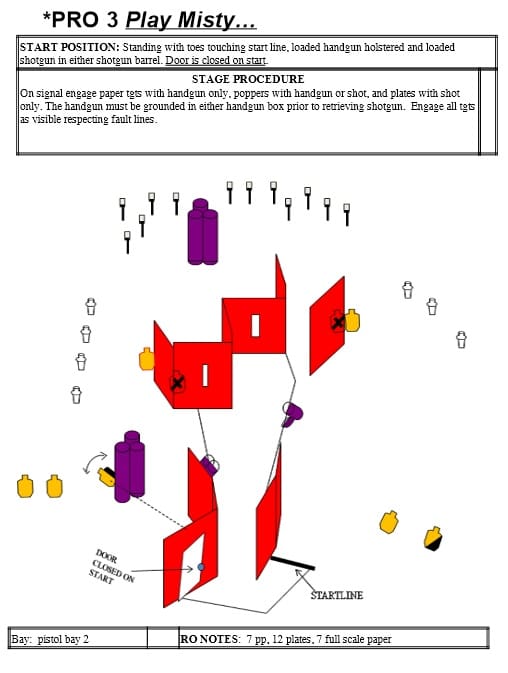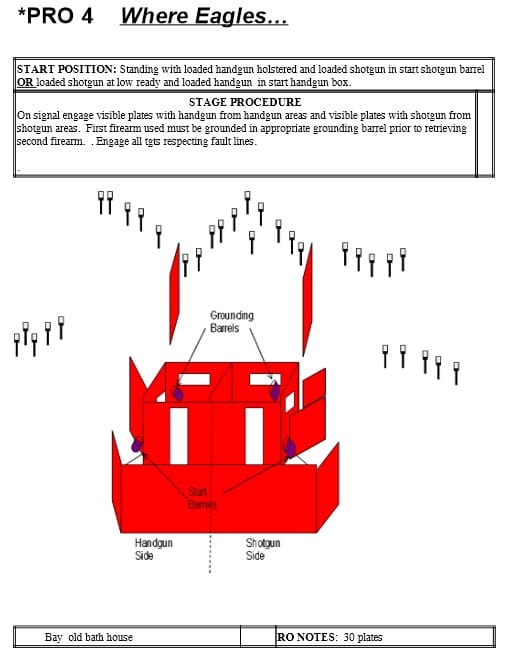The first day of the AR15.com 3-gun went…okay. There were some things I wish I’d done done better (like not hitting the damned no-shoot target), but all-in-all I was doing pretty well. By the end of the second day, theough, my hopes at a strong finish would be in the dumpster . . .
We started the day on stage 3, a straightforward set-up that involved a swinging target and some pepper poppers that could be shot either with a shotgun or a pistol. The option was deceptive, though, as there were so many other shotgun targets that it didn’t make sense to shoot the extra four targets with the shotgun rather than the handgun.
The trick to shotgun shooting is keeping the damned thing loaded. Especially with the TacOps division, you are limited to 9 rounds to start (8 in the tube and 1 in the chamber) and can’t use any fancy feeding devices — hands only. That makes the gun slow to load and quick to run out of ammo which keeps things challenging. So when you have the option to shoot a target with your handgun instead, especially on an otherwise shotgun-intensive stage, you take it.
Where I had trouble with this stage was the first set of shotgun targets and that was because of the design. If you don’t hit the target square-on, the target won’t fall. There’s a metal tab that extends below the target plate that will keep it from rotating off the target stand and I kept hitting that smaller tab just hard enough to keep the thing from falling over. It’s a major pain in the ass and it meant that I lost about 10 seconds trying to hit that thing.
Most of the time, however, wasn’t wasted with the actual shooting. Every time I fired I immediately went to move on to the next position, but when I saw the target still standing up, I had to get back into the shooting stance and re-acquire the target. That process of preparing to shoot a target from a given position is called a “setup” in 3-gun parlance, and adding three unnecessary additional setups to my stage caused me a load of trouble. And time.
Everything else about that stage ran well. But the day was only about to get worse.
The second stage for the day was stage 4, which took place in an old shower house. It was a pretty cool setup, running a handgun on one side and a shotgun on the other and shooting through windows, but the same design features that kept the modesty of the previous users in tact made it challenging to see the targets outside.
The biggest challenge of this stage was keeping your feet underneath you. Most 3-gun stages take place in the dirt or on gravel, somewhere that your cleats can really dig in and give you a good footing. The bath house, on the other hand, was made of slippery concrete and made it very possible that someone could take a tumble and become disqualified as well as concussed. Making it even more challenging was the fact that the shooting positions inside the bath house were on elevated platforms which could either tip over if trodden upon too aggressively or cause you to trip. Good footwork was the key to this challenge, and my intense focus on footwork caused me to screw up on a more important facet of target shooting: finding the targets.
I started with the handgun (we were given an option to start with handgun or shotgun), and there were five handgun targets just outside the front door for me to shoot first. They were tiny little square plates, and so I traded my 4-inch FNS-9 for Larry’s prototype 5-inch FNS-9 competition , with a smaller fiber-optic front sight. It was a good call, since the longer sight radius and smaller front sight let me see the targets and hit them better. But I pulled a “Dirty harry” and forgot if I had shot four or five targets, and wasted about five seconds looking for the last target before moving on. Once inside the pistol side of the bath house I had some trouble staying sunny-side-up on the last platform, but I braced myself against the wall and made it through without falling over.
racing over to the shotgun side, my experience missing a target with the handgun caused me to lose faith in my ability to count, and I wasted another five seconds looking for a nonexistent target over there — only to find that I had indeed hit every target already. More wasted time.
The impact on my score was downright catastrophic. I had been running in the mid-80s in terms of score, but that knocked me down to 149th. I had some ground to make up, and very little time to do it.
The last stage of the day was stage 5, and the entire challenge of this stage was in the handgun shooting. There were about nine small square plates that needed to be hit with a handgun, and shooting those plates quickly would prove to be the key to the whole stage.
Taran Butler came to know this fact very, very well. When he shot this stage, he went to war with one of the handgun plates missing it again and again and again. It took so much time that it put him completely out of the running for the top slots in TacOptics, and reports indicate that he completely lost his cool and started throwing a little temper tantrum on the stage, cursing up a storm.
While the handgun plates would be the biggest indicator of who would do well on the stage, the section that the shooters focused on the most was the 100 yard steel plates at the end of the stage. There was much discussion about whether it was best to go prone in the mud to get a stable shooting position, or whether it was quicker to try and shoot them offhand while bracing against the tree, or if there was some compromise to be hand by kneeling to take the shots.
Personally, I braced off the tree and shot those targets while standing, only missing twice and hitting with a quick follow-up shot. As boring as NRA High Power shooting may be, it certainly does improve your offhand shooting abilities.
The one thing that Eric Lund wanted to smack me around for was the number of times I stopped to shoot the rifle paper targets. There were two arrays of paper targets that needed to be shot, one set on the hill and one set in the bottom of a gully. I had decided that the paper targets up on the hill were a little too close to the 180 line for comfort, and planned to shoot them from the dump barrel a few yards back up range when I picked up the rifle instead. For that “wimping out,” Eric demanded my man card. Nevertheless, I still shot those targets from further back and it ran pretty smoothly.
My match went from “okay” to “train wreck” in out three stages flat. My only hope to rescue an okay score from the disaster that was my growing pile of yellow sheets was to shoot the next two stages flawlessly. It was a tall order, but entirely possible.







Gah I love hese write ups.
Those were some good pistol shots on those tiny targets (particularly at 2:12). I could not have made those. I would need some serious practice to get to that level (if I could get to that level).
Good job.
They don’t look that hard to hit. Doing it quickly however, is a very different story.
I’ll admit that I’m not particularly great a pistol shooting, but I’ve surprised myself a number of times.
The most intimidating target I’ve encountered was a Texas Star at about 15 yards in my first ever 3gun match. I was dead certain I’d dump a mag into it and fail to knock all the plates off.
It went exactly the opposite. If I remember correctly I wasted 3 shots on it. Not only was it incredibly fun, it was a huge confidence booster.
3gun matches really are the most fun you can have with a gun.
Another really interesting report, thanks.
I was impressed that the judge was calling hits on the 100 yard steel, in a few instances, before the sound of the steel ringing made it back to the camera. I’m starting to suspect that having a really good stage judge who’s very sharp with the hit calls can make a difference in a close match.
I for one am impressed. To echo an earlier comment, some of those pistol shots were tough (well, they would be for me – especially under pressure).
Sorry you didn’t do as well as hoped, but I won’t be mocking your abilities anytime soon!
Comments are closed.